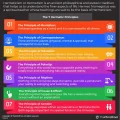
This article discusses a transcript of the speaker’s interpretation of the concept of “Christ,” arguing that it represents an inner truth or divine manifestation accessible to everyone, not solely Jesus. The speaker connects this concept to various spiritual figures like Krishna and Buddha, emphasizing the importance of inner self-discovery over organized religion. He critiques traditional religious structures, promoting the idea of individual spiritual awakening and the inherent divinity within each person. The speaker uses biblical passages and symbolic interpretations to support his claims, encouraging listeners to find their own “Christ” within. He concludes by suggesting that widespread inner peace would lead to harmony with nature and a more peaceful world.

Jesus, Christ, and Divinity Within
What is the meaning of the term “Christ”?
The term “Christ” is not a last name, but rather a title or an ideal representing divine truth. It is a symbolic word for the divine manifestation of God that enters the human mind to destroy error and the lower, carnal aspects of our being.
Was Jesus’ last name Christ?
No, Jesus’ last name was not Christ. His name was Yeshua, a form of the name Joshua. He was considered the Christ, a title he didn’t emphasize because he believed everyone had the potential to manifest the Christ within themselves.
What did Jesus mean when he said “the Father Within Me does the work”?
Jesus was referring to the higher mind, symbolized by the word “Father,” which resides in the right hemisphere of the brain. This largely untapped part of the mind holds vast potential and, when activated, allows us to connect with the divine.
What is the significance of the “witness within” mentioned in 1 John 5:10?
The “witness within” is the indwelling spirit, the divine spark within each of us. Believing in the “Son of God” means acknowledging and nurturing this offspring of the divine principle within our minds. The spirit, the life, the “I AM” presence resides within us all.
Why did Jesus challenge religious institutions?
Jesus challenged religious institutions because he saw them as promoting fear, bondage, and separation rather than true spiritual understanding. He believed that true divinity was found within each individual, not through external rituals or doctrines.
What is the true meaning of “tithing”?
Tithing is not about giving money. It represents dedicating the 10% of our mind associated with the left hemisphere, the logical and analytical side, to spiritual practice and meditation. By quieting the mind, we open ourselves to the divine power within.
What is the significance of the story of Santa Claus in relation to the Christ?
The story of Santa Claus has its roots in spiritual concepts. “Claustrum” refers to the nourishing “milk” or life force flowing from the brain to the solar plexus, symbolizing the Christ’s descent into the physical realm. This “holy claustrum” became “Saint Claustrum” and eventually, Santa Claus. The story reminds us that the true gifts of the Christ come from within.
How can we achieve true salvation and peace according to the source?
True salvation is achieved not through blind faith or external rituals, but by connecting with the Christ within. This involves quieting the mind, seeking the kingdom of God within, and embracing the divine spark that resides in each of us. This inner transformation will lead to individual and collective peace, harmony with nature, and a world where love and compassion prevail.
Unveiling the Inner Christ: A Study Guide
Key Terms Glossary
- Christ: A universal ideal, a Divine manifestation of God that destroys incarnate error and resides within every human mind. It is not a person’s last name, but rather a state of being.
- Incarnate Error: The manifestation of negativity, falsehood, and ignorance within the human experience due to identification with the lower aspects of oneself.
- Carnal: Relating to the lower aspects of human nature, characterized by physical desires and limitations.
- Jeshu/Joshua: The actual name of Jesus of Nazareth, highlighting the misconception of “Jesus Christ” as a name rather than a title and state of being.
- The Father Within: Symbolizes the higher mind, the right hemisphere of the brain, which possesses divine potential that can be activated.
- Claustrum: A thin sheet of neurons in the center of the brain, metaphorically representing the “oil of life” and connected to the concepts of Christ and Santa Claus.
- Sacrum: The five fused vertebrae at the base of the spine, symbolizing the union of the five senses into one and representing a sacred point in the body.
- Single Eye: Refers to the pineal gland and the concept of focusing inward to access inner wisdom and divine connection.
- Tithe: Symbolically, giving 10% of one’s mind (the left hemisphere) to the higher power to achieve spiritual awakening.
- Born Again: Shedding old beliefs and limitations to experience a spiritual rebirth and awaken to one’s true nature.
Short Answer Quiz
- What is the speaker’s central argument regarding the term “Christ”? (2-3 sentences)
- Explain the speaker’s understanding of the phrase “the Father Within.” (2-3 sentences)
- According to the speaker, what is the symbolic meaning of the “claustrum”? (2-3 sentences)
- How does the speaker interpret the biblical concept of “tithing”? (2-3 sentences)
- What is the significance of the “sacrum” in relation to the speaker’s message? (2-3 sentences)
- What point does the speaker make about the relationship between Krishna, Buddha, and Jesus? (2-3 sentences)
- How does the speaker criticize the traditional understanding of salvation? (2-3 sentences)
- Explain the speaker’s perspective on the origins of the Easter celebration. (2-3 sentences)
- According to the speaker, what is the true meaning of “confessing Jesus Christ as Lord”? (2-3 sentences)
- How does the speaker connect negative vibrations with natural disasters? (2-3 sentences)
Short Answer Quiz Answer Key
- The speaker argues that “Christ” is not Jesus’s last name but rather a universal ideal representing a Divine manifestation of God that resides within every human being. Achieving Christ consciousness means destroying incarnate error and awakening to one’s true divine nature.
- “The Father Within” is a symbol for the higher mind, specifically the right hemisphere of the brain. The speaker explains that this part of the brain holds immense untapped potential and, when activated, allows individuals to connect with their divine nature.
- The speaker uses “claustrum” as a metaphor for the “oil of life” that flows throughout the body, originating in the brain and descending into the solar plexus. This metaphorical journey connects to the concepts of Christ and Santa Claus, both symbolizing the giving of life and spiritual nourishment.
- The speaker reinterprets the traditional notion of tithing, arguing that it’s not about giving money but about dedicating 10% of one’s mind (symbolized by the left hemisphere) to the higher power. This mental surrender allows individuals to discover the “switch” that activates their inner Christ.
- The “sacrum,” formed by the fusion of five vertebrae at the base of the spine, represents the unification of the five senses into one. This symbolizes the integration of physical experiences into a higher spiritual awareness, crucial for accessing the inner Christ.
- The speaker highlights the similarities between Krishna, Buddha, and Jesus, suggesting that they all represent the same universal truth and embody the Christ consciousness. They are all Divine incarnations who came to guide humanity toward spiritual awakening and liberation.
- The speaker criticizes the idea that salvation comes from merely confessing belief or adhering to religious doctrines. True salvation, according to the speaker, comes from embodying the teachings of Jesus and activating the Christ within oneself, not from external rituals or pronouncements.
- The speaker claims that the Christian celebration of Easter originates from the Babylonian goddess Ishtar, associated with prostitution and sex. The speaker criticizes the adoption of this pagan festival, suggesting that it undermines the true meaning of Christ’s resurrection and promotes materialism over spiritual growth.
- Confessing “Jesus Christ as Lord,” according to the speaker, means more than just uttering the words; it requires living in alignment with Jesus’s teachings. This includes practices like meditation, seeking inner wisdom, and recognizing the Kingdom of God within oneself.
- The speaker proposes a link between negative vibrations emanating from human minds and natural disasters. He argues that the collective negativity disrupts the harmony of nature, resulting in ecological imbalances and catastrophic events. Conversely, cultivating inner peace and spiritual connection can restore balance and promote planetary healing.
Essay Questions
- Analyze the speaker’s use of biblical references and Christian symbolism to support his argument about the true meaning of Christ. How effective are these appeals to religious authority in conveying his message?
- Explore the speaker’s critique of organized religion and religious institutions. What specific practices and beliefs does he challenge, and what does he propose as an alternative path to spiritual fulfillment?
- Discuss the speaker’s emphasis on personal experience and inner revelation as the foundation for spiritual understanding. How does this contrast with traditional religious teachings, and what are the potential implications of prioritizing individual insight over external authority?
- Analyze the speaker’s concept of “incarnate error” and its role in preventing individuals from accessing their true divine nature. What are the sources and manifestations of this error, and how can it be overcome?
- Evaluate the speaker’s vision of a world where humanity embraces the “Christ within” and lives in harmony with nature. What are the potential benefits and challenges of achieving this state of collective consciousness, and what specific actions does the speaker suggest individuals take to contribute to this transformation?


















0 responses on "Unveiling the inner christ in you"